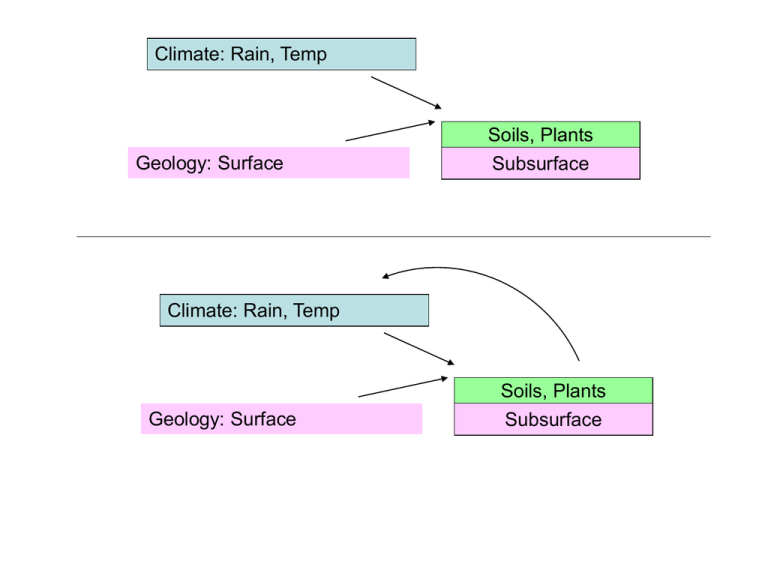Climate: Rain, Temp Soils, Plants Geology: Surface Subsurface
advertisement

Climate: Rain, Temp Geology: Surface Soils, Plants Subsurface Climate: Rain, Temp Geology: Surface Soils, Plants Subsurface Langley = 1 cal/cm2 CD > AB means more light absorbed by atm, less to surface Great Lakes = 105 Langleys/day Dec 500 langleys/day summer Reflection is measured by “albedo” Absorption by surface Reflection by atmosphere Reflection by surface Absorption by atm. Month Dec. Summer Langley 105 500 Albedo 80-90% (snow) Wind from south and west Prairie!! Forest locations Soil deposits Wind from North, sometimes east Bending direction of air mass (dishpan) leads to thermals: thunderstorms, rapid temperature change (40-50 degrees). 1/2 Chicago moisture = Tstorm Shifting wind directions, give rise to thermals, which give rise to thunderstorms Prairies!! Chicago not really part of this classificaton : cold winters, no dry season, cool summer Lake effect: Material flow within the lake. Movement of sand south, also movement of pollutants north “Whiting” of the Lake occurs in the warmer months. CO2 rises due to Biological activity. The high calcium content of the lake (Silurian reef!) Results in CaCO3 precipitation. The amount of Ca depends upon Particulate matter stirring of the lake bed and sides. Particulate matter as Measured by satellite Reflection measurements Program Goal to create an integrated observational and numerical modeling program for the winter-spring resuspension event(s) and to assess their impact on the transport and transformation of biogeochemically important materials and on lake ecology. Three fundamental hypotheses focus this program: Hypothesis 1: The plume is a result of the first winter-spring storm after ice-out and represents the resuspension of particulate materials (and associated constituents have been stored in the lake as surface sediment "floc" for a distribution of times, during which they have undergone differential diagenesis. Hypothesis 2: The forced, two-gyre vorticity wave response of the lake to episodic wind events, occasionally modified by stratification, is a major mechanism for nearshore-offshore transport of particulate matter and associated constituents in the Great Lakes. Hypothesis 3 : Physical processes, (e.g. resuspension, turbulence) associated with the plume event are important in determining the nutrient and light climate, and in structuring the biological communities throughout the spring isothermal period, and in setting the conditions for the critical 'spring bloom' period. Lake Effect 1. Wind direction 2. Microclimate 3. Regional climate 4. Currents 5. Surface deposits and Erosion (bluffs and sand) No ice means more evaporative loss of water Water levels important in determining water temp and bacteria counts Beach closings No scientific basis, but rise and fall used to be on an ~11 year cycle Lake Levels – Predicting the Effect of Global Warming Drier climate Means soil And plants Will adsorb More water Less runoff Into the lake Predicted Effects of Lake level fall 1. 2. 3. 4. 5. Broader beaches Boaters will have less access to docks and marinas Commercial navigation crippled – have to carry lighter loads Completely unknown effect on lake biology (invasive species etc.) Alteration of water withdrawals policies for NE Illinois Troubles discussed in this Article are primarily related To marina access N Average wind Directions (average Over OHare/Midway High thermals rising = Bird migrations Shore breeze – temperature gradients in flora along lake front Shore breeze – effects on pollutants Shore breeze – effects on placement of sand dunes, bluffs Wave action depends on distance traveled. Wave breaks when water depth = 4/3 wave height. Lake effect: precipitation and microclimates Fetch = distance that waves can build as well as clouds. For non-snow determines wave height and surges. A big wind can mass transport water at 5% speed of wind = Lake Shore Drive closings. Lake effect on frost free days!!! Should have fewer frost free period, frost free days variable in Chicago area = microclimates Plant hardiness zones Variable rainfall within Chicago area results indifferent microclimates Large diversity of ecological niches. Chicago average 34 inches. S. Dunes, 36 Rainfall variation nationally Restricts prairie to west. Pennisula survives: thunderstorms Does not extend further east (rain) Rain Bedrock Surface deposits South moving sand Wetlands Geology Weather West Nile Virus! Habitat Diversity = Species Diversity From: Species Diversity in Space and Time, Michael L. Rosenzweig Summary 1. Winds are generally from west during the hot summer Means blowing soil from west, deposits to east Means, fire blows east, stops on western side of rivers Means, forests used to lie to the eastern side 2. Jet stream shifts = thunderstorms, = survival of prairie outside of current climatic range 3. Lake effect 1. Lake breezes, wave action – sand and bluffs 2. Lake breezes, thermals – bird migrations 3. microclimates along lake, large variations in ppt and temp = very high biological diversity! Last time: we finally set up an experiment worthy of an An air pollution expert NE NNE N ENE 61 46 E 30 15 0 -15 -30 -46 -61 0 15 30 46 61 SE Incinerator 1994, 1995, 1998 Backtrajectories July 5, 2000 July 27, 2000 July 17, 2000 [ng/m3] 10000 1000 ng/m3 TXRF Martina Schmeling LUC Spectrochim. Acta B In Press 100 10 Pb 1 0.1 0.01 S K Ca Ti V 5-Jul-00 Cr Mn Fe 17-Jul-00 Ni Cu 27-Jul-00 Zn Br Sr Pb


